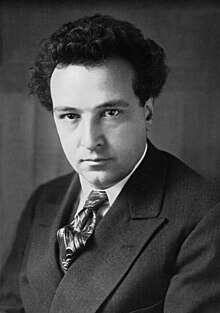Symphony No. 4 (Honegger)
| Symphony No. 4 | |
|---|---|
| Deliciæ Basilienses | |
| by Arthur Honegger | |
 The composer in 1928 | |
| Composed | 1946 |
| Dedication | Paul Sacher |
| Performed | 21 January 1947: Basel |
| Movements | three |
The Symphony No. 4 by Swiss composer Arthur Honegger is a work for orchestra, written in 1946 on a commission from Paul Sacher. Subtitled Deliciæ Basilienses,[1] it was first performed on 21 January 1947, by the chamber orchestra Basler Kammerorchester under Sacher. On the same program were the premieres of two other works commissioned by Sacher: Igor Stravinsky's Concerto in D and Bohuslav Martinů's Toccata e due Canzoni.
Honegger's symphony, which contains musical quotations from two Basel folk songs, expresses the composer's happiness during a pleasant stay in the Swiss countryside after the end of World War II.[2] Despite the pastoral and often joyous mood throughout much of the symphony, the closing minutes include some tragic or more serious elements.
Honegger's Fourth Symphony is a three-movement work with a total running time of about 27 minutes. The movements are titled:
- Lento e misterioso - Allegro (approx. 11'45")
- Larghetto (approx. 6'15")
- Allegro (approx. 8'30")
This symphony is published by Éditions Salabert.
Recordings[edit]
Recordings of this symphony include full sets of Honegger's symphonies performed by:
- the Czech Philharmonic Orchestra under Sergei Baudo (Supraphon, 1994)
- the Suisse Romande Orchestra under Fabio Luisi (Cascavelle, 2001)
- the Toulouse Capitole Orchestra under Michel Plasson (EMI Classics, 2004)
- the Bavarian Radio Symphony Orchestra under Charles Dutoit (Apex, 2006)
Additional recordings of this symphony include:
- the Suisse Romande Orchestra under Ernest Ansermet (London/Decca Enterprise, 1991)
- the Bournemouth Sinfonietta under Tamás Vásáry (Chandos, 1992)
- the Lausanne Chamber Orchestra under Jesús López-Cobos (Virgin Classics, 1992 and 2001)
- the French National Radio Orchestra under Charles Munch (Apex, 2002)
- the Basel Chamber Orchestra under Christopher Hogwood (Arte Nova, 2005)
- the London Philharmonic Orchestra under Vladimir Jurowski (live recording LPO, 2011)
References[edit]
- ^ Deliciae Basilienses.
- ^ Honegger: Symphonies 1-5 • Pacific 231 • Rugby (CD liner notes). Warner Classics, 2006. p. 6.
